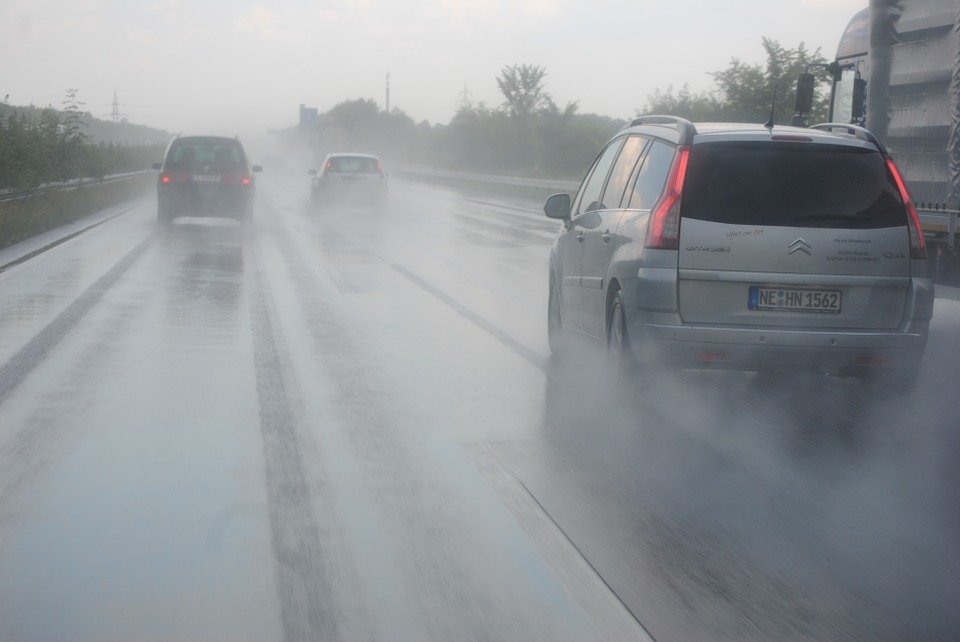What is aquaplaning (aka hydroplaning)?
Anytime we find standing water on the road our vehicles run the risk of aquaplaning. The standing water causes the vehicles tyres to lose contact with the road surface and in effect your car is floating on the water rather than driving on the road.
When a vehicle is aquaplaning the driver loses control of the vehicle and won't regain control until the tyres grip part of the road surface again. This can present the driver in an incredibly dangerous situation allowing a fast moving vehicle to be completely out of control.
What conditions can cause aquaplaning?
Standing water is the cause of aquaplaning and can come from many sources. The most common source for standing water is from heavy or persistent rain allowing water to collect or not drain fast enough. We can also see standing water form due to blocked drains, water leaks or the result of other situations such as flooding or emergencies.
Any standing water has the potential to allow aquaplaning to happen regardless of how it got there.
How do we avoid aquaplaning?
In order to prevent aquaplaning we need to ensure the cars tyres are able to disperse the water below them and keep grip on the road. In many circumstances it is very hard to prevent aquaplaning and thus we should also take considerable care when the conditions are bad.
- Reduce vehicle speed
Keeping your cars speed down will give more time for the specialist groves in the tyres to disperse the water out of the way. It also allows more time for the water to naturally move out the way of the incoming tyres and thus keeps your tyres gripped to the road. - Ensure tyres are kept in good condition
Replacing your tyres as they wear is good practice but also helps with aquaplaning. Many tyres have grooves known as secondary tread which are designed to push water out of the way but don't form part of the legal tread requirements of 1.6mm. The more tread pattern you have (including secondary grooves), the more chance of displacing water you have. It's also essential to keep your tyre pressures correct to keep the grooves pushing out water. - Follow other vehicles
If you are in a line of traffic, try to keep your tyre line on the same path as the car in front. As you follow the vehicle in front it will clear water out of the way and hopefully won't fully return until after you have passed too. - Avoid standing water
It's not always possible, and some standing water can be invisible from a drivers perspective. But where possible avoid driving through standing water and when you have to, dramatically reduce your speed to make the pass safely. If in doubt, don't drive through. - Avoid cruise control in the rain
Unless your paying extra attention, cruise control can keep you accelerating through standing water and won't slow down if it detects standing water. Leaving cruise control turned on can significantly increase your chance of aquaplaning during heavy or persistent rain. - Smooth driving
A great tactic is to keep your driving style to slow and smooth. When making turns, accelerating or braking you should avoid sudden and drastic changes. This allows the tyres the chance to clear water, find traction and perform as intended. It also means that the weight of the vehicle isn't shifting direction quickly, thus reducing opposing forces on the tyres.
How should I react if I find myself aquaplaning?
If you find yourself losing control at high speed it can be very scary and daunting. The current advise for drivers who find themselves aquaplaning is to do the following, be warned though that this is slightly different to finding yourself in a skid.
- Stay Calm
By staying calm you will be in a position to address the situation, retain any control you do have and puts you in a position to react once traction does return. - Slow the car down naturally
Lift your foot off the accelerator and allow the cars speed to decrease naturally. If you are using cruise control then switch this off immediately. By allowing the car to slow down naturally the weight of the vehicle will also go over the front wheels to allow traction. - Do not brake
Applying the brakes won't have any effect and can potentially cause the car to deviate on its course and skid. Never hit your brakes when aquaplaning. - Do not steer adversely
When you are aquaplaning your steering has no impact on the direction of your vehicle as you are not in contact with the road. If you adversely steer you will find once traction returns that your vehicle may suddenly shoot off in a different direction or enter a skid.
